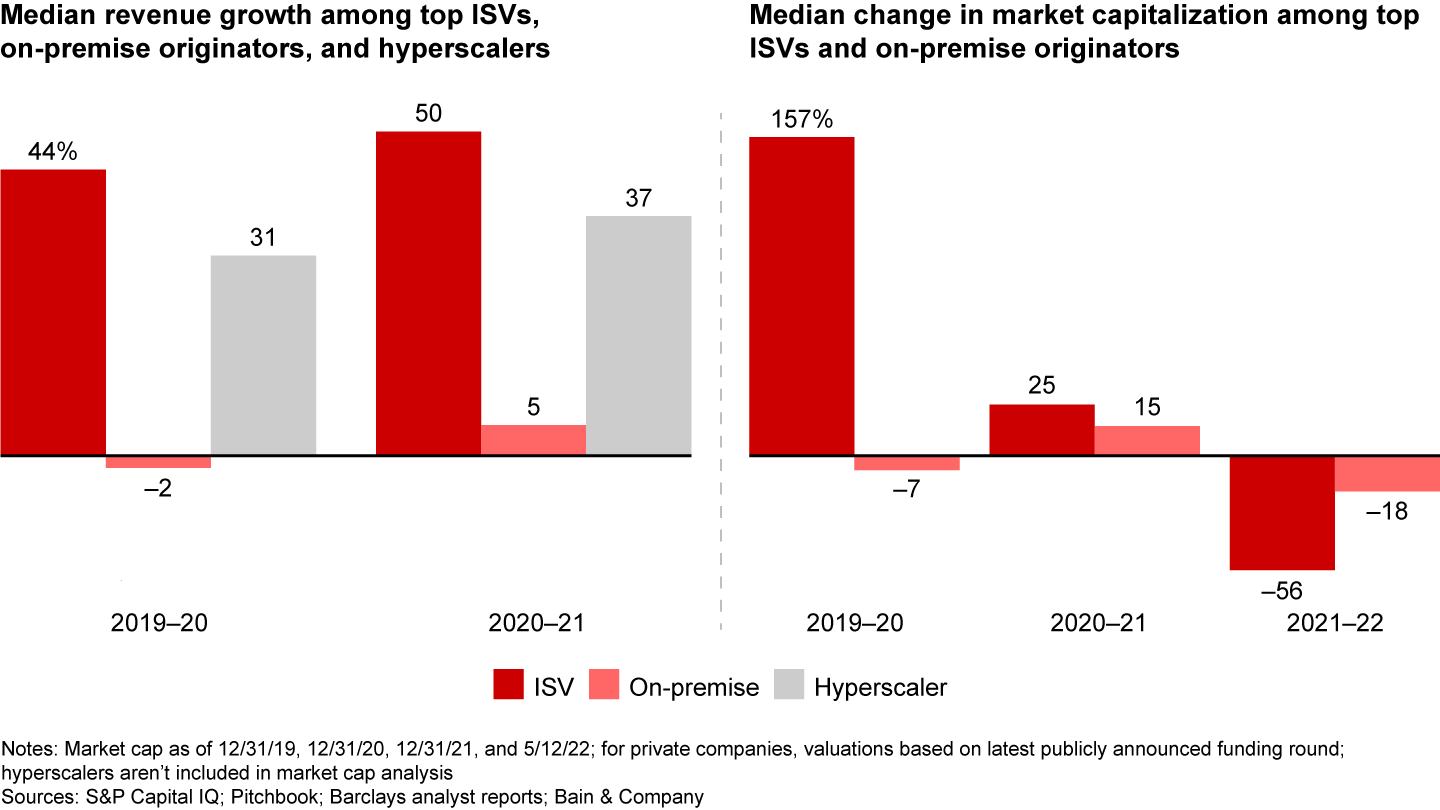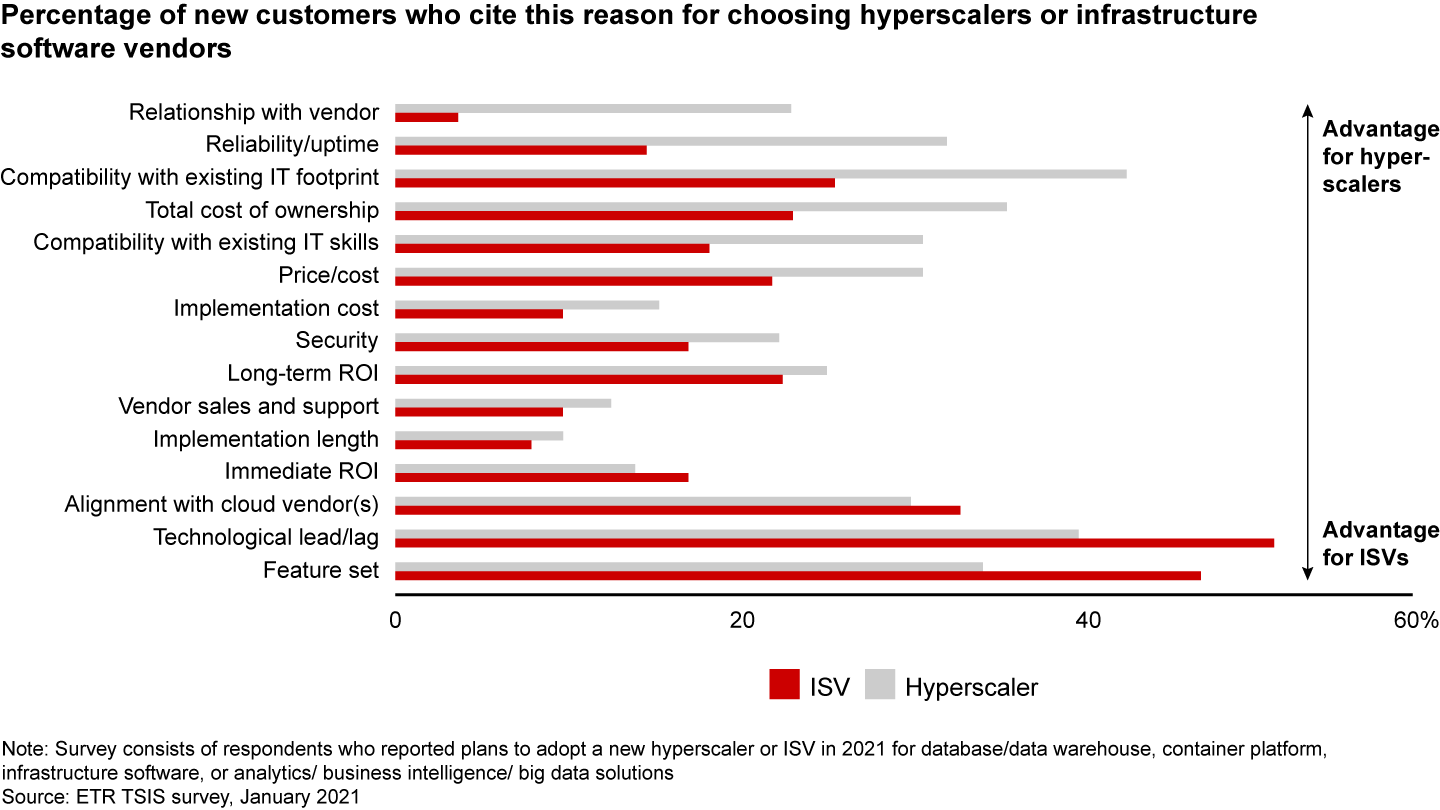Technology Report
 }
}
Executive Summary
- The multicloud software market has grown tremendously in recent years, but not all companies can survive.
- Three factors will determine an ISV’s likelihood to succeed in a given market: whether customers will pay for premium functionality, whether they want to avoid locking into walled gardens, and whether hyperscalers’ benefits of scale provide a unique advantage.
This article is part of Bain's 2022 Technology Report.
After the valuations of multicloud infrastructure software vendors shot into the stratosphere over the past three years only to start crashing down to earth in late 2021, investors and enterprise customers are left wondering, who will survive and thrive?
It’s one of the most consequential questions in technology right now, because it has significant bearing on who will win the cloud software market: multicloud infrastructure software vendors (ISVs), hyperscaler cloud service providers, or on-premise originators (see definitions of these three groups in “Cloud Software Competitors” below).
Multicloud ISVs’ rapid growth in value indicated an expectation of transformative market penetration and massive revenue growth over the next few years. Indeed, revenue growth of top multicloud ISVs has exceeded that of both hyperscalers and on-premise originators, increasing by a median of 44% from 2019 to 2020 and 50% from 2020 to 2021 (see Figure 1). Their market valuations increased by a median of 157% from 2019 to 2020 and 25% from 2020 to 2021. Some ISVs enjoyed valuations 50 times higher than their annual revenue, more than triple the average software multiple.

It wasn’t sustainable. As macroeconomic challenges dragged down the stock market overall, multicloud ISV valuations declined even more steeply, even as their revenue growth often exceeded expectations. In time, it will become clear whether this is an overcorrection or a reset that better reflects intrinsic value. However that plays out, it’s increasingly clear that the competition between multicloud ISVs and hyperscalers will determine the future of the cloud software market. As investors and enterprises evaluate their cloud strategies, here’s our guide to what will determine the winners.
Three swing factors
The strength of a multicloud ISV’s advantage in a segment hinges on three characteristics.
- Customers’ willingness to pay a premium for best-of-breed solutions. Multicloud ISVs have an opening to differentiate themselves in parts of the cloud stack located further from hyperscalers’ core offerings. Customers already choose ISVs when they need best-in-class technology, and for certain key purchase criteria (see Figure 2).
- Strong customer preference for cloud infrastructure flexibility. Multicloud ISV solutions that work consistently across computing environments are well suited to buyers that want to avoid vendor lock-in and simplify their multicloud or hybrid environments.
- Relatively limited benefit from scale. ISVs are more likely to succeed when this key advantage of hyperscalers’ platforms isn’t critical.

The future of ISVs
These three swing factors help clarify when ISVs are better positioned to win, when they’ll face fierce competition from hyperscalers, and when hyperscalers have the advantage.
- ISVs are in a good position to win when best-in-class technology and cloud infrastructure flexibility are paramount. Examples include cybersecurity and app monitoring. In cybersecurity, despite hyperscalers’ moves to bolster their offerings (such as Google Cloud Platform’s $5.4 billion Mandiant acquisition), multicloud ISVs will be formidable competition, well positioned on all three swing factors. Cloudflare, for example, has upped the game for web performance and security with its differentiated software architecture and innovation. The combination has powered the company beyond investor analysts’ revenue growth expectations, more than tripling its total addressable market estimate from $32 billion in 2018 just before its 2019 IPO to over $100 billion.
- ISVs and hyperscalers will engage in fierce competition when best-in-breed technology may be beneficial but not necessary. Examples include data warehousing and database management. In data warehousing, we believe multicloud ISVs can continue carving out leading positions in the market, but doing so will require overcoming strong hyperscaler presence and investment, as well as managing the complex relationship between ISVs and hyperscalers in those market segments where they both compete and partner. Snowflake has enjoyed a spectacular rise, including the largest software IPO at that point in history. Similarly, Databricks has demonstrated exceptional strength, reaching $800 million in annual recurring revenue in 2021, 80% more than in 2020.
- Hyperscalers could capture the majority of profit pools when they have a distinct technological edge, a significant lead in the market, or an overwhelming advantage from scale. This may include areas within artificial intelligence (AI) and machine learning (ML), such as AI developer frameworks or vision and natural language processing. Hyperscalers get differentiated benefit of scale from training AI/ML solutions on large data sets and across multiple tools. In this segment, customers are already voting with their dollars, spending around 60% of their AI/ML budgets on hyperscalers’ tools, compared with 25% on multicloud ISV solutions, according to a 2022 Bain survey. We still expect to see ISVs winning in areas of AI further from the hyperscaler core, however, including cases involving proprietary data or domain-specific functionality.
Implications for ISVs, hyperscalers, and on-premise originators
As the cloud services industry matures, multicloud ISVs should play a larger role in the market, but hyperscalers will maintain a strong competitive position, and on-premise originators have an opportunity to carve out their own valuable niche.
On-premise originators have two important strengths to draw upon: a large installed base of customers and well-known brand names. Rather than trying to beat hyperscalers, we expect more on-premise originators to form partnerships and invest in making their leading software offerings work seamlessly on top of hyperscalers’ platforms.
Critical questions for on-premise originators to consider as they crystallize their strategies:
- What’s the source of our competitive differentiation from hyperscalers and multicloud ISVs today? What will it be in the future?
- How can we partner with hyperscalers to keep customers from seeking a new solution?
Successful multicloud ISVs will disproportionately invest in products located further from the hyperscaler core that have hybrid or multicloud requirements and limited benefits from scale. By maintaining a focus on customer needs and delivering best-in-class solutions, they can continue to win. One wild card to watch is regulation. If regulators require more standardization and interoperability, that’s likely to benefit multicloud ISVs.
Critical questions for multicloud ISV leadership teams:
- Do hyperscalers view our markets as must-win battlegrounds or as distant adjacency bets?
- In markets with attractive swing factors, how can we create maximum value?
The most effective hyperscalers will assess their portfolio of services to determine where their scale delivers a needle-moving competitive advantage and where best-of-breed players have the edge. As their service offerings expand from hundreds today to potentially thousands in the future, hyperscalers will need to effectively manage that complexity while remaining an easy-to-use one-stop shop for customers.
Critical questions for hyperscalers:
- Which priority areas of our core business should we invest in to ensure we stay ahead of the competition?
- In which limited number of critical adjacent software markets should we invest? How will these further differentiate us from other hyperscalers?

